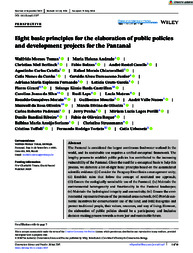Eight basic principles for the elaboration of public policies and development projects for the Pantanal.
Eight basic principles for the elaboration of public policies and development projects for the Pantanal.
Author(s): TOMAS, W. M.; ANDRADE, M. H.; BERLINCK, C. N.; BOLZAN, F.; CAMILO, A. R.; CATELLA, A. C.; CHIARAVALLOTI, R. M.; CUNHA, C. N. da; DAMASCENO JUNIOR, G. A.; FERNANDO, A. M. E.; GARCIA, L. C.; GIRARD, P.; IKEDA?CASTRILLON, S. K.; SILVA, C. J. da; LAPS, R.; MATEUS, L.; MORATO, R. G.; MOURAO, G.; NUNES, A. V.; OLIVEIRA, M. da R.; OLIVEIRA, M. D. de; PADOVANI, C. R.; PENHA, J.; PERILLI, M. L. L.; RIBEIRO, D. B.; ROQUE, F. de O.; SORIANO, B. M. A.; STRUSSMANN, C.; TOFFOLI, C.; TORTATO, F. R.; URBANETZ, C.
Summary: Abstract: The Pantanal is considered the largest continuous freshwater wetland in the world, and its sustainable use requires a unified conceptual framework. The lengthy process to establish public policies has contributed to the increasing vulnerability of the Pantanal. Given the need for a conceptual basis to help this process, we elaborate a list of eight basic principles based on the accumulated scientific evidence: (i) Consider the Paraguay River Basin a management unity; (ii) Establish rules that follow the concept of restricted use approach; (iii) Ensure the ecologically sustainable use of the Pantanal; (iv) Maintain the environmental heterogeneity and functionality in the Pantanal landscapes; (v) Maintain the hydrological integrity and connectivity; (vi) Ensure the environmental representativeness of the protected areas network; (vii) Provide economic incentives for conservationist use of the land; and (viii) Recognize and protect traditional people, their values, resources, and way of living. However, the elaboration of public policies should be a participatory and inclusive decision?making process towards a more just and sustainable future.
Publication year: 2024
Types of publication: Journal article
Unit: Embrapa Pantanal
Observation
Some of Embrapa's publications are published as ePub files. To read them, use or download one of the following free software options to your computer or mobile device. Android: Google Play Books; IOS: iBooks; Windows and Linux: Calibre.
Access other publications
Access the Agricultural Research Database (BDPA) to consult Embrapa's full library collection and records.
Visit Embrapa Bookstore to purchase books and other publications sold by Embrapa.

